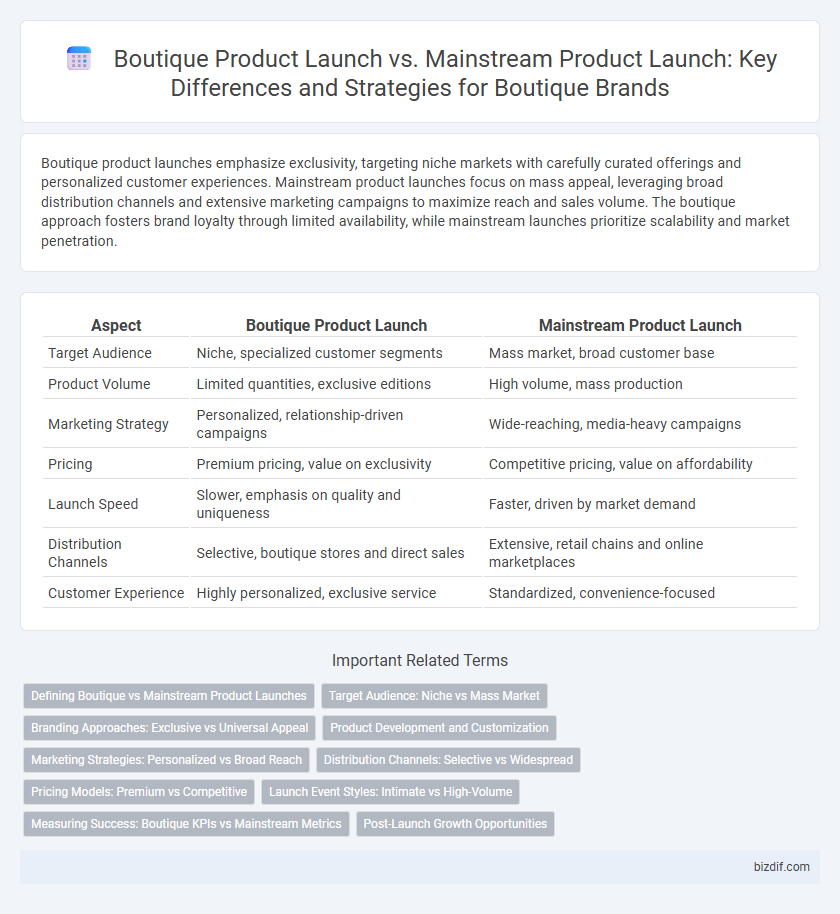Boutique product launches emphasize exclusivity, targeting niche markets with carefully curated offerings and personalized customer experiences. Mainstream product launches focus on mass appeal, leveraging broad distribution channels and extensive marketing campaigns to maximize reach and sales volume. The boutique approach fosters brand loyalty through limited availability, while mainstream launches prioritize scalability and market penetration.
Table of Comparison
| Aspect | Boutique Product Launch | Mainstream Product Launch |
|---|---|---|
| Target Audience | Niche, specialized customer segments | Mass market, broad customer base |
| Product Volume | Limited quantities, exclusive editions | High volume, mass production |
| Marketing Strategy | Personalized, relationship-driven campaigns | Wide-reaching, media-heavy campaigns |
| Pricing | Premium pricing, value on exclusivity | Competitive pricing, value on affordability |
| Launch Speed | Slower, emphasis on quality and uniqueness | Faster, driven by market demand |
| Distribution Channels | Selective, boutique stores and direct sales | Extensive, retail chains and online marketplaces |
| Customer Experience | Highly personalized, exclusive service | Standardized, convenience-focused |
Defining Boutique vs Mainstream Product Launches
Boutique product launches target niche markets with highly specialized and limited-edition offerings, emphasizing unique value propositions and personalized customer experiences. Mainstream product launches cater to a broad audience, focusing on mass appeal, extensive distribution, and high-volume sales strategies. The distinction lies in boutique launches prioritizing exclusivity and tailored branding, while mainstream launches emphasize scalability and widespread market penetration.
Target Audience: Niche vs Mass Market
Boutique product launches target niche audiences with specialized interests, offering unique, high-quality items designed to meet specific needs and preferences, which fosters strong customer loyalty. Mainstream product launches aim for mass market appeal, emphasizing broad accessibility, scalability, and competitive pricing to maximize market penetration and sales volume. Strategic marketing for boutique launches often involves personalized communication and limited edition releases, while mainstream launches rely on extensive advertising and wide distribution channels.
Branding Approaches: Exclusive vs Universal Appeal
Boutique product launches emphasize exclusive branding strategies that target niche markets with personalized experiences, fostering strong customer loyalty and a sense of uniqueness. In contrast, mainstream product launches utilize universal appeal by adopting broad-reaching campaigns designed to attract mass audiences and maximize market penetration. The branding approach in boutique launches often leverages rarity and craftsmanship, while mainstream launches highlight accessibility and widespread relevance.
Product Development and Customization
Boutique product launches emphasize tailored product development, focusing on unique features and high customization to meet niche customer demands. In contrast, mainstream product launches prioritize scalability and broad appeal, often standardizing features to streamline production and distribution. Customized solutions in boutique launches drive innovation and differentiation, while mainstream products rely on market-tested designs and efficiency.
Marketing Strategies: Personalized vs Broad Reach
Boutique product launches emphasize personalized marketing strategies targeting niche audiences through tailored messaging, exclusive events, and direct customer engagement to create a unique brand experience. Mainstream product launches utilize broad reach marketing tactics, including mass media advertising, social media campaigns, and influencer partnerships to maximize visibility and attract a large, diverse customer base. The boutique approach fosters deeper emotional connections and brand loyalty, while mainstream strategies prioritize widespread awareness and rapid market penetration.
Distribution Channels: Selective vs Widespread
Boutique product launches typically employ selective distribution channels, targeting niche markets through specialized retailers or exclusive online platforms to maintain brand exclusivity and high perceived value. In contrast, mainstream product launches utilize widespread distribution, leveraging mass retailers, major e-commerce sites, and broad retail networks to maximize market penetration and accessibility. The strategic choice between selective and widespread distribution channels significantly impacts brand positioning, customer reach, and overall sales performance.
Pricing Models: Premium vs Competitive
Boutique product launches often adopt premium pricing models to emphasize exclusivity, craftsmanship, and niche market appeal, allowing higher profit margins and reinforcing brand prestige. In contrast, mainstream product launches prioritize competitive pricing strategies to capture broader markets, focusing on volume sales and accessibility, resulting in lower margins but greater market penetration. The choice between premium and competitive pricing critically impacts positioning, target audience, and overall revenue dynamics in product launch strategies.
Launch Event Styles: Intimate vs High-Volume
Boutique product launches prioritize intimate event styles that foster personalized customer engagement, creating exclusive and memorable experiences tailored to niche markets. Mainstream product launches favor high-volume events designed for broad reach and maximum exposure, leveraging large-scale venues and mass media coverage to generate widespread buzz. The choice between these styles depends on brand strategy, target audience, and desired market impact.
Measuring Success: Boutique KPIs vs Mainstream Metrics
Boutique product launches prioritize niche KPIs such as customer engagement depth, brand exclusivity index, and personalized satisfaction scores to measure success, reflecting tailored consumer experiences and high-touch interactions. Mainstream product launches rely on broader metrics including market penetration rates, overall sales volume, and mass-market share to gauge performance at scale. The contrast highlights the boutique focus on quality and brand loyalty, whereas mainstream metrics emphasize quantitative reach and rapid growth.
Post-Launch Growth Opportunities
Boutique product launches typically focus on niche markets with highly targeted customer segments, allowing for personalized marketing strategies that foster strong brand loyalty and organic word-of-mouth growth. In contrast, mainstream product launches aim for broad market penetration, leveraging mass advertising and extensive distribution channels to accelerate post-launch sales volume and market share. Post-launch growth for boutique products often hinges on cultivating exclusive customer experiences and iterative product enhancements, while mainstream products benefit from scaling operations and optimizing supply chain efficiencies.
Boutique Product Launch vs Mainstream Product Launch Infographic

 bizdif.com
bizdif.com